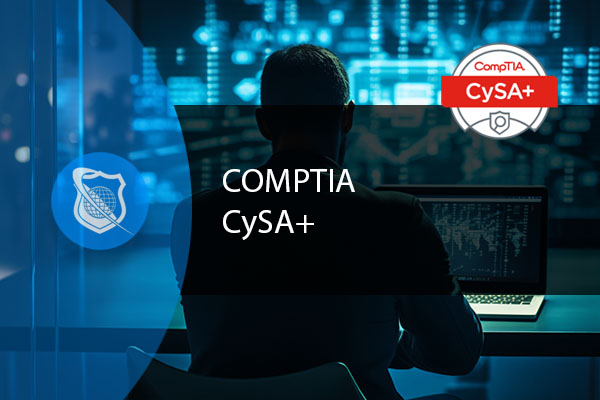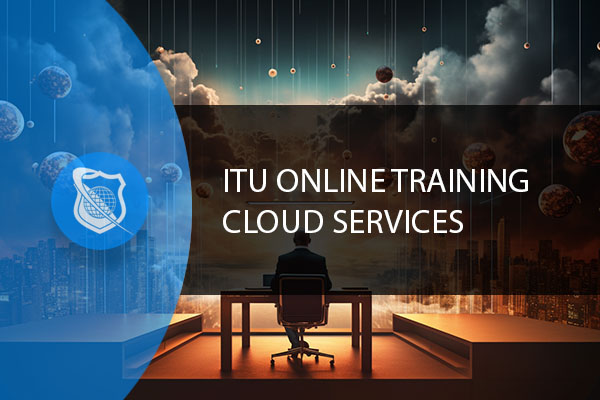Let’s dive into Virtualization, Containers, and Serverless Computing. These three technologies stand out for their transformative impact: virtualization, containers, and serverless computing. These innovations are not just buzzwords; they represent significant shifts in how we deploy, manage, and secure IT resources. This blog aims to unpack each of these concepts, delving into their benefits, inherent vulnerabilities, and the overarching implications for security. Whether you’re an IT professional, a business leader, or just a tech enthusiast, understanding these technologies is crucial in navigating today’s digital landscape.

CompTIA CySA+ Training
Ready to fortify digital landscapes? Unleash your potential with our CySA+ course. Master behavioral analytics, shield networks, and become a certified defender against cyber threats. Elevate your security prowess, ace the CompTIA CySA+ (CS0-003) exam, and secure a resilient future for organizations
Deep Dive into Virtualization
Core Concept and Types of Virtualization: Virtualization refers to creating a virtual version of something, such as a server, a storage device, or network resources. It involves abstracting physical resources to create multiple simulated environments or dedicated resources. Common types include server virtualization, network virtualization, and storage virtualization.
Hypervisors Explained: At the heart of virtualization is the hypervisor, a software layer that allows multiple operating systems to share a single hardware host. There are two types: Type 1 (or bare-metal) hypervisors like VMware ESXi and Microsoft Hyper-V, which run directly on the hardware, and Type 2 hypervisors that run on a conventional operating system.
Benefits of Virtualization: The advantages are numerous – it maximizes resource utilization, enhances flexibility, reduces hardware costs, and simplifies disaster recovery processes.
Common Vulnerabilities: However, virtualization introduces specific vulnerabilities. VM hopping, for instance, is an attack where a malicious actor jumps from one VM to another. VM jacking involves gaining unauthorized control over the hypervisor, posing a significant security risk.
Mitigation Strategies: To counter these vulnerabilities, implementing robust security measures such as regular software updates, network segmentation, and strict access controls is essential.
Understanding Containers
Containers vs. Virtual Machines: Containers offer a lightweight alternative to full-blown VMs, virtualizing the application layer rather than the entire operating system. This means they require fewer resources, offer faster start times, and ensure consistent operation across different computing environments.
Benefits of Containers: Containers provide a streamlined way to package and deploy applications, ensuring consistency across environments and improving development and operational efficiency.
Security in the Containerized World: Despite their efficiency, containers are not without security concerns. They share the host’s kernel, which can expose vulnerabilities if not properly managed. Ensuring containers are isolated, using secure container registries, and regular vulnerability scanning are key practices.
Real-World Applications and Case Studies: Major tech companies like Google and Amazon use containers to power vast portions of their cloud services, leveraging their scalability and efficiency.

Get Ahead In Cloud Computing
At ITU, we offer an exclusive Cloud Computing training series designed to prepare you for certification and/or to help you gain knowlege of all Cloud based platforms including AWS, Azure and Gooogle Cloud.
Get access to this exclusive Cloud Computing Training today.
Exploring Serverless Computing
What is Serverless Computing?: Serverless computing abstracts the server layer, enabling developers to focus solely on code. This model automatically manages the allocation of machine resources.
Advantages of Going Serverless: Serverless architectures offer several benefits, including cost-efficiency, as you pay only for the resources you use, scalability, and ease of deployment.
Security Concerns in Serverless Architectures: However, this convenience comes with unique security challenges. The ephemeral nature of serverless can complicate monitoring and security, and the reliance on third-party services raises concerns about security configurations and compliance.
Best Practices for Serverless Security: Implementing strong identity and access management (IAM) policies, thorough code reviews, and regular security assessments are crucial for maintaining a secure serverless environment.
Integration and Overall Security Considerations
Integrating virtualization, containers, and serverless computing can lead to a highly efficient, flexible, and scalable IT infrastructure. However, it’s crucial to adopt a holistic security approach that encompasses all layers and components of the infrastructure. Regular updates, robust access controls, continuous monitoring, and a culture of security awareness are vital in safeguarding these technologies.
Conclusion
Virtualization, containers, and serverless computing are reshaping the IT landscape, offering unprecedented levels of efficiency and flexibility. However, with great power comes great responsibility – particularly in terms of security. By understanding these technologies and their associated risks, IT professionals can better prepare to meet the challenges of today’s dynamic technology environment. As these technologies continue to evolve, staying informed and vigilant will be key to leveraging their benefits while minimizing potential risks.
Choose Your IT Career Path
ITU provides you with a select grouping of courses desgined specfically to guide you on your career path. To help you best succeed, these specialized career path training series offer you all the essentials needed to begin or excel in your choosen IT career.
Key Term Knowledge Base: Key Terms Related to Introduction to Virtualization, Containers, and Serverless Computing
Understanding key terms in the realms of virtualization, containers, and serverless computing is essential for anyone delving into these areas of technology. These concepts represent significant advancements in the way computing resources are utilized and applications are deployed and managed. Virtualization allows for more efficient use of physical hardware, containers offer a lightweight and portable means to run applications, and serverless computing enables developers to build and run applications without the overhead of managing servers. Familiarity with the terminology used in these fields is crucial for effectively working with these technologies, whether you’re a developer, an IT professional, or just a tech enthusiast.
| Term | Definition |
|---|---|
| Virtualization | The process of creating a virtual version of something, such as a virtual computer hardware platform, operating system, storage device, or network resources. |
| Hypervisor | A software layer that enables virtualization by allowing multiple operating systems to share a single hardware host. |
| VM (Virtual Machine) | An emulation of a computer system that provides the functionality of a physical computer. |
| Container | A lightweight, standalone, executable package of software that includes everything needed to run an application: code, runtime, system tools, libraries, and settings. |
| Docker | A platform used to develop, ship, and run applications inside containers. |
| Kubernetes | An open-source system for automating deployment, scaling, and management of containerized applications. |
| Serverless Computing | A cloud-computing execution model where the cloud provider runs the server and dynamically manages the allocation of machine resources. |
| Function as a Service (FaaS) | A category of cloud computing services that provides a platform allowing customers to develop, run, and manage application functionalities without the complexity of building and maintaining the infrastructure. |
| Orchestration | The automated configuration, coordination, and management of computer systems, applications, and services. |
| Microservices | An architectural approach to building an application as a collection of small services, each running in its own process and communicating with lightweight mechanisms. |
| Stateless | A computing architecture in which the server does not store any state about the client session. |
| Stateful | In contrast to stateless, a computing architecture where the server keeps track of the state of the interaction with the client. |
| API Gateway | A server that acts as an API front-end, receiving API requests, enforcing throttling and security policies, passing requests to the back-end service, and then returning the response. |
| Load Balancer | A device that distributes network or application traffic across a number of servers to improve the efficiency and reliability of applications. |
| Scalability | The ability of a system, network, or process to handle a growing amount of work, or its potential to be enlarged to accommodate that growth. |
| Elasticity | The ability of a system to automatically adjust and allocate resources to maintain a steady, predictable performance. |
| Cloud Computing | The delivery of different services through the Internet, including data storage, servers, databases, networking, and software. |
| Virtual Network | A software-based network that exists within a virtualized environment. |
| VPC (Virtual Private Cloud) | A private cloud computing environment contained within a public cloud. |
| Infrastructure as a Service (IaaS) | A form of cloud computing that provides virtualized computing resources over the internet. |
| Platform as a Service (PaaS) | A category of cloud computing services that provides a platform allowing customers to develop, run, and manage applications without the complexity of building and maintaining the infrastructure typically associated with developing and launching an app. |
| Compute Engine | A component of cloud computing platforms that provides large-scale computing capacity, often in a virtualized environment. |
| Container Registry | A repository for storing, managing, and securing container images. |
| CI/CD Pipeline | Continuous Integration/Continuous Deployment. A method to frequently deliver apps to customers by introducing automation into the stages of app development. |
| YAML | A human-readable data serialization standard that can be used in conjunction with all programming languages and is often used to write configuration files. |
| Stateless Application | An application that does not save client data generated in one session for use in the next session with that client. |
| Stateful Application | An application that saves data about each client session and uses that data in the next session with that client. |
| Resource Pooling | In cloud computing, the provider’s computing resources are pooled to serve multiple consumers using a multi-tenant model. |
| Virtual Desktop Infrastructure (VDI) | A virtualization technology that hosts a desktop operating system on a centralized server in a data center. |
| Hyperscale Computing | A computing architecture that scales significantly better when additional resources are added. |
| Immutable Infrastructure | An infrastructure management paradigm where components are replaced rather than changed. |
| Cloud Service Provider (CSP) | A company that offers some component of cloud computing – typically Infrastructure as a Service (IaaS), Software as a Service (SaaS) or Platform as a Service (PaaS) – to other businesses or individuals. |
| Bare Metal Server | A physical computer server that is dedicated to a single tenant. |
| Virtualization Layer | The software layer in which virtualization occurs, separating the physical hardware from the virtual environments. |
| Cloud Native | A term used to describe applications that are built to operate in cloud environments. |
| Edge Computing | A distributed computing paradigm that brings computation and data storage closer to the sources of data. |
| Serverless Architecture | An approach to building and running applications and services without having to manage infrastructure. |
| Container Orchestration | The process of managing the lifecycles of containers, especially in large, dynamic environments. |
| Infrastructure as Code (IaC) | The process of managing and provisioning computer data centers through machine-readable definition files, rather than physical hardware configuration or interactive configuration tools. |
| DevOps | A set of practices that combines software development (Dev) and IT operations (Ops) to shorten the development life cycle and provide continuous delivery with high software quality. |
| Cloud Migration | The process of moving data, applications or other business elements to a cloud computing environment. |
Frequently Asked Questions Related to Virtualization, Containers, and Serverless Computing
What is Virtualization?
Virtualization involves creating virtual versions of technology resources like computer hardware platforms, storage devices, and network resources. It allows multiple operating systems to share a single hardware host.
What are Containers?
Containers are lightweight packages that isolate a service and its dependencies into a self-contained unit. This unit can run in any environment, promoting efficient use of server space and resources. Containers provide operating-system-level virtualization, unlike VMs which provide hardware virtualization.
What is Serverless Computing?
Serverless computing is a cloud computing model where the cloud provider manages the allocation and provisioning of servers. It eliminates the need for infrastructure management tasks like server provisioning, patching, and capacity provisioning.
How do Containers differ from Virtual Machines?
Containers are more lightweight than virtual machines as they share the host’s operating system, unlike VMs that require their own OS. Containers are ideal for running modern applications and offer faster startup times and greater scalability, while VMs provide more robust isolation and are suitable for legacy applications.
What are the benefits of Serverless Architecture?
Serverless architecture offers lower operational costs, simplified scalability, quick deployment, and reduced liability for backend infrastructure. It’s ideal for applications with fluctuating traffic patterns and those that need to scale quickly on demand.

























